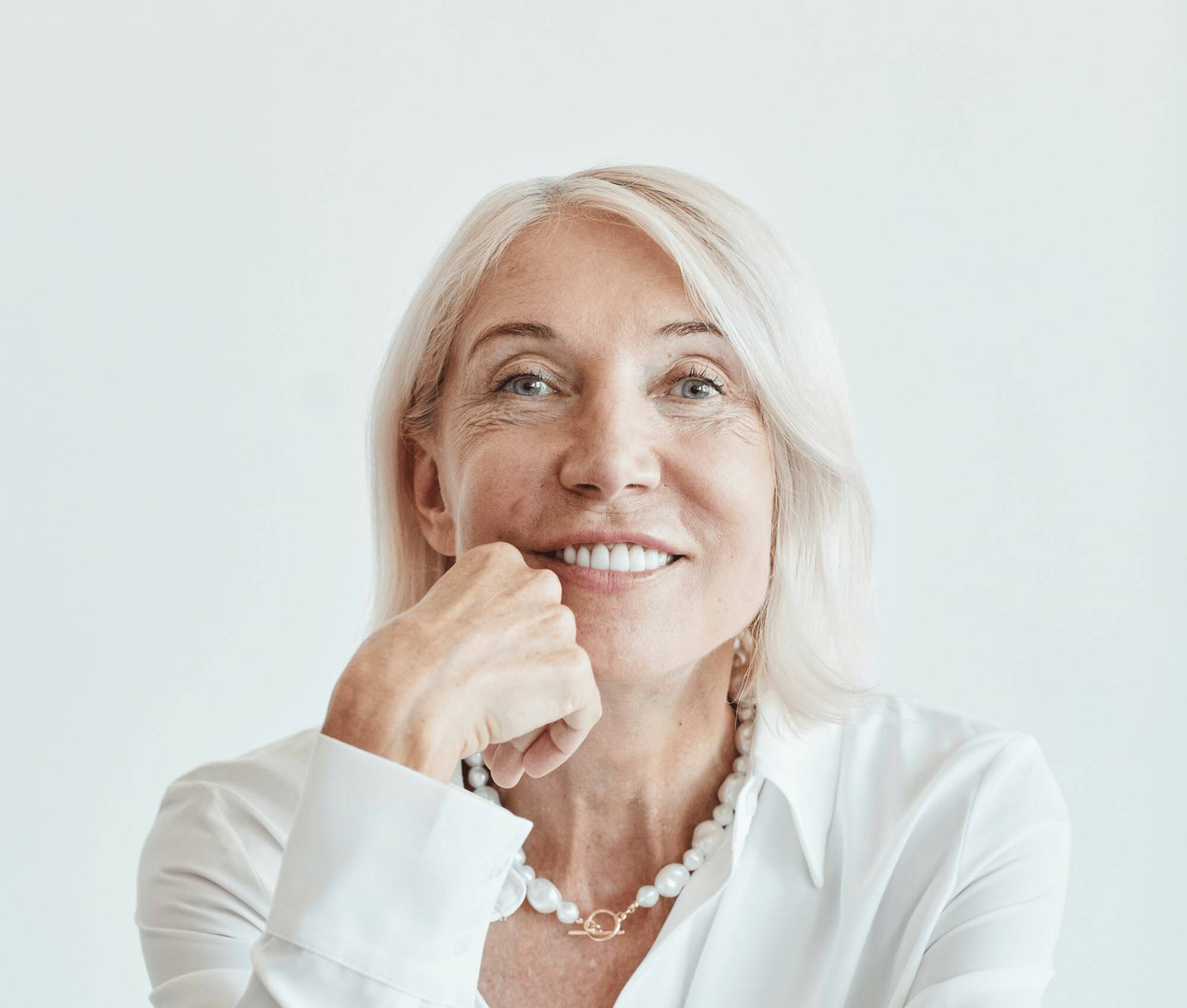Endometriosis is a common (and uncommonly pretty sh*tty and painful to live with) condition whereby tissue that is similar to the lining of the uterus (endometrium) grows outside of the uterus in other parts of the body, particularly the pelvis.
Endometriosis (aka endo) affects 190 million females and people assigned female at birth globally, but despite the large number of people living with it, there’s still a lot we don’t know about it.
Not only is endo incredibly painful and extremely under-researched, but because of how little is known about the disease, it also takes a bloody long time to receive a diagnosis. Exactly how long are we talking? On average, it takes an individual around about 8.3 years to receive a diagnosis.
To help let that number sink in, that’s 99.5 months, 432 weeks, and 3030 days that endo warriors are forced to live without answers and the life-changing support they need to help manage their condition. And in our opinion, that’s 99.5 months, 432 weeks, and 3030 days too long.
It’s time someone finally shed some light on the truth behind endometriosis, and today, we’re here to do exactly that.
What is Endometriosis?
Despite pain being one of the key signifiers of the condition, endometriosis is more than just pelvic pain; it’s a progressive, inflammatory disease that impacts the whole body and can significantly alter countless aspects of a person’s life.
Endometriosis has been shown to affect an individual’s physical, mental, and social well-being, and in severe cases, a person’s ability to work.
Predominantly found in females and people assigned female at birth of reproductive age, endometriosis is defined as the growth of endometrial-like tissue outside of the uterus.
This misplaced tissue is most commonly found in the fallopian tubes, ovaries, bladder, bowels, and tissue lining the ovaries and behaves like the lining inside the uterus would. With each menstrual cycle, endometriosis tissue thickens and bleeds. Hazel doctor, Melissa Catanzarite, confirms that endometriosis has also been found in the brain, lungs, diaphragm and legs and adds that autopsies have found endo tissue in every region of the human body.

But, unlike the cells within your uterus, this tissue doesn’t break down and shed every 28 days or so. Instead, it continues to build up over time, leading to inflammation, scarring, and cysts.
Oh, and did we mention it can also result in adhesions? If you weren’t already sitting down, you might want to sit down for this.
Endometriosis adhesions are clumps of thick scar tissue that can bind organs together and cause serious pain and fertility problems (more on this below).
What Are The Common Symptoms of Endometriosis?
In addition to holding people hostage and making them want to crawl up into a ball every 28 or so days, there are a few other unmistakable markers of endometriosis. These can include some (or all) of the following symptoms:
- Chronic pelvic pain
- Dysmenorrhea
- Dyspareunia
- Heavy menstrual bleeding
- Non-menstrual pelvic pain
- Chronic fatigue
- Pain at ovulation
Endometriosis is a complex condition that can vary significantly from person to person. Some people with endometriosis experience no symptoms, while others may also experience these less common symptoms:
- Abdominal bloating (often referred to as endo belly)
- Abnormal periods
- Constipation and nausea
- Mood swings
- Pain when emptying the bladder and/or bowels
- Severe, lasting pain in the legs and back
Many people living with endometriosis say that their symptoms started in their teenage years, but because their pain was trivialised by doctors and other healthcare professionals, it wasn’t until years later that they finally received a diagnosis.
Endometriosis and Fertility
Because there is no endometriosis rule book (no, really – this condition does what it wants), endo can affect each person differently. This means that while endo can sometimes affect fertility, in other cases, it can have no impact on fertility at all.
Because the effects of endo can vary so much, it’s important to seek support, guidance, and answers from a trusted healthcare provider who sees you as an individual case (and not another statistic) and provides you with a unique care plan to address your signs and symptoms.
Can Endometriosis Cause Infertility?
While more research is needed to determine if endometriosis causes infertility, there is a strong association between the severity of the disease and the presence of infertility.
Research has shown that between 30-50% of people with endometriosis suffer from infertility, while a total of 25-50% of women (and people with a uterus) experiencing infertility are later treated for endometriosis.
So, while it is important to remember that infertility does not affect every person with endometriosis, and not every person battling with infertility is affected by endometriosis, it can be a significant concern for many individuals.
One study suggests infertility in people with endometriosis may be a result of:
- Immune disorders.
- Oxidative stress.
- Endocrine disorders and abnormalities.
- Bacterial infections
If you suspect that you might be experiencing difficulties conceiving because of endometriosis, you don’t have to walk this road alone. Our specialist Hazel doctors have extensive experience in managing endometriosis, and will work with you to provide you with the answers and support you deserve.

How Is Endometriosis Diagnosed?
The most common and definitive way to confirm an endometriosis diagnosis is via laparoscopy. Laparoscopy is a form of keyhole surgery that enables doctors to visualise and potentially remove endometrial tissue. One of the advantages of laparoscopic surgery is that patients can receive their diagnosis and treatment at the same time (+1 point for efficiency).
If endometriosis can be seen during the laparoscopy, a sample will be removed to confirm the diagnosis, with treatment depending on where the endometriosis was found (and how much of it was found). However, the extraction and removal of abnormal tissue unfortunately doesn’t always prevent it from growing back.
Dr Melissa says, "it is also important to note that this procedure does not always end the pain. In many cases, women have just as much pain after the procedure."
In some cases, endometriosis can also be visualised on imaging tests such as ultrasounds or MRIs.
While the journey to receiving a diagnosis can be physically and emotionally exhausting, (which is to be expected after waiting an average of 8.3 years for a definitive answer!) Many people still find relief in finally receiving an explanation for their previously unexplained symptoms.
How Is Endometriosis Treated?
PSA: You don’t have to just grin and bear it.
Not only are endometriosis treatments available to you, but they can also help to:
- Improve your quality of life
- Reduce symptoms of endometriosis, including pelvic pain
- Prevent more severe disease from happening later in life
- Reduce the likelihood of future fertility problems
Treating endometriosis involves a range of different approaches that aim to target chronic pain, improve the quality of life of each patient, and reduce the growth of endometrial tissue. Endometriosis treatments can be categorised into the following categories:
- Surgical Treatment
- Medical Treatment
- Natural Medicines
Surgical Treatment
In so much pain you just want to cut the bloody thing out? Well, good news! There are professionals ready to do just that! Laparoscopic surgery is the most common way to confirm endometriosis. It’s also an effective first-line approach for removing endometrial growths via keyhole surgery.
If you’re going down the surgery route, know that just like any other treatment, it also comes with its own benefits and risks. Laparoscopic surgery comes with the risk of damaging healthy tissue within the uterus and can cause further adhesions (scar tissue) and worsen pain. Dr Melissa states that "there is no guarantee that it will solve the pain, or that all the endo will be found and removed, or that it will even be found at all!".
But (and it’s a big BUT) — just because surgery is common, that doesn’t mean it’s your only option for treatment. If it has worked for you in the past, that’s great, but if you’re still exploring treatment options, it’s important you know that surgery isn’t always a necessary step to undergo in order to treat endometriosis.
Medical Treatment
If you’ve consumed what feels like an entire bathtub’s worth of green tea to no avail, there’s something a little stronger out there for you. Those suffering from mild to moderate pain associated with endometriosis can usually manage their pain using over-the-counter pain medications. However, those experiencing more prolonged, severe pain might find that over-the-counter medications provide little to no relief.
In these circumstances, we recommend speaking to a trusted doctor who can support you in prescribing pain medications for more long-term relief from your severe pain.
While pain medication can be great for relieving pain (and hey, we love it for that too!) pain medication only provides partial relief of symptoms. It doesn’t come with extra bells and whistles to address mood-related symptoms, sleep problems, gastrointestinal issues, and mental health struggles.
So, if your endometriosis involves more than pelvic pain (and chances are it does), you might want to look into using pain medication alongside another treatment option or exploring other methods altogether.
Natural Medicines
We thought we’d take a moment to remind you that no matter what treatments your doctor or healthcare professionals suggest to you, it’s your body and you get to choose what your treatment looks like.
Here are some natural medicines that have been shown to help manage endometriosis symptoms:
Supplements
You are what you eat, and when we fuel our bodies with good and nutritious foods, supplements, and liquids, magic happens. Endometriosis and inflammation go hand in hand, with inflammation recognised as a key driver for chronic pain. What does that have to do with what we consume?
Well, studies have shown that supplements such as Omega-3 and alpha-lipoic acid work to reduce inflammation, thereby improving endometriosis-associated pain.
Medicinal Cannabis
Looking for a greener (no, literally), natural, plant-based alternative to endometriosis treatment? Enter medical cannabis. Medicinal cannabis has been found to address the following symptoms associated with endometriosis:
- Poor sleep.
- Mood changes.
- Chronic pelvic pain.
- Gastrointestinal issues.
An an anti-inflammatory and anti-oxidant property, medicinal cannabis has also been found to reduce the rate of endometrial tissue growth and improve mental health in some people, making it a potential alternative for those looking to manage their symptoms and pain without conventional medicine or surgery.
Naturopathy
Treatment for endometriosis doesn’t always have to involve doctor’s visits, surgery, and trialling different medications. If you’re interested in taking a holistic, natural approach to your healing, you might like to consider naturopathy.
Studies show that some herbal medicines found in naturopathic practices are able to interact with the body’s biological processes, and, when used in conjunction with other therapies, can assist in alleviating pain and other symptoms associated with endometriosis.
Our naturopaths understand that no two endometriosis patients have the same symptoms and approach each patient with an individualised treatment plan to help address your specific symptoms and concerns that impact you and your life.
If you’re interested in exploring naturopathy incorporating natural medicines into your endometriosis treatment plan, book a consultation with one of our caring naturopaths.
What Is The Best Treatment for Endometriosis?
Just like with any other chronic condition, endometriosis treatment requires proper management of symptoms that should be individualised and differ from person to person.
The best treatment plan for endometriosis is the treatment plan that works best for YOU and addresses your specific needs and goals. If you’re ready to stop being ignored and ready to start being heard, our team of Hazel doctors are here to support you on your journey.
You won’t find any one-size fits-all approaches to endo here, nor will you have to encounter any dismissive docs. What will you find instead? A dedicated group of professionals who are team you, and work with you (and each other) to help manage your pain in a way that works best for you.
Managing Endometriosis with Hazel
For too long, women and people with a uterus have been forced to accept severe pain as just another non-negotiable fact of life, and it’s no different for people with endometriosis. But, just because pain is common, doesn’t mean it’s normal, and it’s time healthcare professionals started taking note of that.
You know your body better than anyone, and engaging the help of a caring professional who listens to you is key to receiving an accurate diagnosis and effective treatment plan. Understanding that many of our patients have spent years suffering from their undiagnosed symptoms – we’re not here to waste time. Our care providers have the knowledge to dig deep and go beyond the surface to understand your symptoms and pain to offer comprehensive care plans, tailored to you.
The Bottom Line
Endometriosis is a (painfully) misunderstood, underdiagnosed and underfunded condition. But that doesn’t mean that you have to suffer in silence. Booking a consultation with a Hazel specialist is the first step to receiving the answers and care you’ve always deserved.
From natural therapies to more conventional methods (such as medical and surgical treatment), whatever your preferred treatment plan looks like Hazel is here to help.
Endometriosis FAQ:
Adenomyosis vs Endometriosis: What’s the Difference?
If you think endometriosis is a misunderstood, misrepresented, and under-researched women’s health condition, you’ll want to buckle up for this introduction.
Allow us to introduce you to Adenomyosis – commonly referred to around here as endo’s lesser-known cousin. Adenomyosis causes heavy bleeding, painful cramps, anaemia, and dyspareunia (aka pain during sex) and affects around 1 in 5 menstruators. Despite sharing a few of the same symptoms as endometriosis, adenomyosis is a completely different condition entirely.
As we explained earlier, in endometriosis, cells that look like the ones that line your uterus begin to grow outside of the uterus (in places like the fallopian tubes, ovaries, or pelvic lining). In adenomyosis, cells similar to those that line the uterus begin growing into the muscular wall of the uterus.
Because the treatment of each condition is so vastly different, it’s important that you reach out to an expert in women’s health if you’re experiencing painful periods, chronic pelvic pain, heavy bleeding, or painful sex so they can create an appropriate treatment plan for you.
At this point in time, Dr Melissa confirms that the only cure for adenomyosis is hysterectomy.
Does a Hysterectomy Cure Endometriosis?
Short answer, kinda.
Long answer, not really. Here’s why.
A hysterectomy is the second most common surgical procedure for women and folks with a uterus, involving the surgical removal of an individual’s uterus. Following a hysterectomy, an individual can no longer menstruate or get pregnant. This is a win-win for folks who only experience endometriosis within their uterus, with studies proving that these individuals receive relief from their pain and are alleviated from the heavy bleeding associated with endo.
However, when endometriosis exists outside of the uterus, that’s when things can get a little tricky. Endo warriors with endometrial tissue wrapped around their ovaries and/or fallopian tubes will find little to no relief from a hysterectomy, given that the catalyst for their pain still exists inside them.
So, in short, a hysterectomy may work for some individuals…but unfortunately, its effectiveness is not guaranteed for everyone. If you’re considering whether or not a hysterectomy could be the right option for you, we recommend reaching out to an expert in women’s health and female pain for a non-biased discussion on the best treatment plan for you.

- Allman J. Exploring medicinal cannabis in endometriosis. March 17, 2021. Accessed October 19, 2023. https://www.hospitalhealth.com.au/content/clinical-services/article/exploring-medicinal-cannabis-in-endometriosis-691948801.
- Bahat PY. Dietary supplements for treatment of endometriosis: A review. Acra Biomed. 2022;93(1). doi:10.23750/abm.v93i1.11237
- Balan A, Moga MA, Dima L, et al. An overview on the conservative management of endometriosis from a naturopathic perspective: Phytochemicals and medicinal plants. Plants. 2021;10(3):587. doi:10.3390/plants10030587
- Benagiano G, Brosens I, Habiba M, Lippi D. History of adenomyosis. Uterine Adenomyosis. Published online 2015:1-8. doi:10.1007/978-3-319-13012-5_1
- Bouaziz J, Bar On A, Seidman DS, Soriano D. The clinical significance of endocannabinoids in endometriosis pain management. Cannabis and Cannabinoid Research. 2017;2(1):72-80. doi:10.1089/can.2016.0035 Denny E. The experience of living with endometriosis. Deep Pelvic Endometriosis. Published online May 19, 2011:79-92. doi:10.1007/978-88-470-1866-2_4
- Denny E. Women’s Experience of Endometriosis. Journal of Advanced Nursing. 2004;48(6). doi:10.1111/jan.2004.48.issue-6
- Diagnosis of endometriosis. Jean Hailes. September 5, 2023. Accessed October 19, 2023. https://www.jeanhailes.org.au/health-a-z/endometriosis/diagnosis.
- Global study shows the experience of Endometriosis is rooted in genetics. University of Oxford. March 14, 2023. Accessed October 19, 2023. https://www.ox.ac.uk/news/2023-03-14-global-study-shows-experience-endometriosis-rooted-genetics.
- Hsu AL, Khachikyan I, Stratton P. Invasive and non-invasive methods for the diagnosis of endometriosis. 2010;53(2). doi:10.1097/GRF.0b013e3181db7ce8
- Hysterectomy. Johns Hopkins Medicine. November 16, 2022. Accessed October 19, 2023. https://www.hopkinsmedicine.org/health/treatment-tests-and-therapies/hysterectomy.
- Ilangavan K, Kalu E. High prevalence of endometriosis in infertile women with normal ovulation and NORMOSPERMIC partners. Fertility and Sterility. 2009;93(3). doi:10.1016/j.fertnstert.2009.11.027
- Jacobson TZ, Duffy JM, Barlow DH, Koninckx PR, Garry R. Laparoscopic surgery for pelvic pain associated with endometriosis. Cochrane Database of Systematic Reviews. Published online 2009. doi:10.1002/14651858.cd001300.pub2








.avif)







